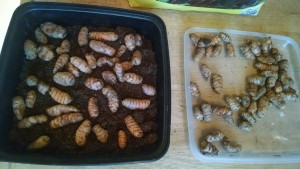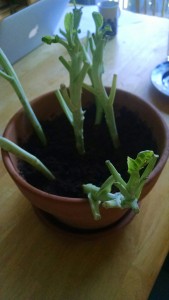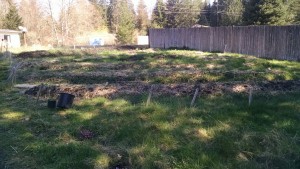Monthly report: March 2016
So, here’s what happened in March. The biggest lesson I learned, an overview look at what happened, and the money that’s been spent so far for this season’s efforts growing food.
Biggest lesson
I hope this isn’t painfully silly for an adult to learn, but I rediscovered a mental tool to discover the most important thing to do on a given day (at least, for procrastinators). I sit and think for a minute about the thing that I most want to put off doing. Might be cleaning up an ignorable mess in the yard, making an unpleasant phone call like setting up an appointment with the doctor, or finally deciding which crops I’m going to not grow this year, so I can start planting seed flats.
I know that I typically put off what I dread until it becomes a bad enough problem to need dealing with. In the process, causing a good deal of stress and perfectly avoidable problems. So, for me, the highest value thing I can do in any given day is to fend off days/weeks/months of chronic stress and dumb problems. That is a very motivating thought, and so far has been enough to help me do very well at this.
And then I’m acting from desire of a carrot instead of pain from getting beaten by a stick, which is another nice thing. In the case of tasks relating to the garden, literally out of desire for carrots…
Bonus lesson: the second biggest lesson is that seed swapping is awesome. And I feel like a chump for not having done more of it. Oh well, next year…
What happened in March
I wish I had taken better notes — I’ll do better next month. I think I’ll try keeping a garden notebook the same way I kept lab notebooks in school. Anyway, here are some of the important things that were done:
Planting inside
– Set up grow lights in the kitchen
– Planted two flats of seeds, for 144 starts of: garlic and potatos (yep, from seed!), four kinds of tomatos, jerusalem artichoke, okra, sweet and hot peppers, broccoli, oregano, and lavendar.
– Planted three packets of onions to make sets: red, yellow, and walla walla sweet.

– Planted ginger and 0.67lbs of turmeric in flat. They’ll go outdoors later.

– Rooting tree collard cuttings

Planting outside
– Planted garlic. Way late, but better than nothing. Hopefully.
– Planted sprouty little russet and yukon gold potatoes, the entirety of last year’s crop.
– Planted peas outside. We’ll see how long they take to germinate…

Other stuff
– Got permission from a few people in the area to undomesticate some vegetables on their land.
– Made a simple shelf on the back porch to keep containers from rotting the wood
– Bought wood to make a beehive. We’ll see if it gets finished in time for bees this year.
Money
Time for the numbers! This’ll include all expenses so far for this growing season. Starting next month I’ll keep season-to-date tallies as well as monthly expenditures.
Raised beds, 500 square feet
$274 – 8 yards compost from Bailey’s compost. Good stuff. I know that over years I could have built this fertility into the soil, but I’m starting with pretty poor soil. The additional yield just this year should pay for the compost in terms of grocery bill savings.
$14 – 2 bales straw for mulch. I <i>do not</i> like bare soil!
$7 – cover crop mix. I don’t like wasting sunlight on mulch.
$15 – tarp. I wanted to keep my driving from getting muddy, and didn’t have enough tarpage to cover the size of the pile. I’m including this here because I had to buy it for this project, even though I’ll get more use out of it.
$0 – a day of hard labor by myself and and Dad. (Thanks Dad!)
$0 – bed walls, path materials, landscaping cloth, equipment rental, etc. I kept it very simple: just mounded compost with no walls, no double digging or rototilling, etc. I like making things simple. It’s elegant, and almost always easier, cheaper, and environmentally healthier than making things complicated.
Total cost for 500 square feet of raised beds: $310
Seed starting setup
$20 – 2 fluorescent grow lights.
$20 – fluorescent fixture
$0 – borrowed grow lights. I borrowed $40 worth of grow lights and fixture from Dad.
$12 – extension cord
$20 – three seed trays
$0 – seed tray I already had. Would have been $6 or $7 extra.
$12 – two bags of potting soil. Next year I plan to make my own, but didn’t have time this year.
$0 – cardboard and paper. I put a couple layers of cardboard and paper in the seed trays, underneath the flats as a capillary wicking mat. Like this, but with cardboard. It works great.
This setup is working fine. Watering with capillary mats is extremely easy and nice. I’ve got it going on shelving in my kitchen island, so the temperature is good. I could probably use another light fixture — my seedlings are a little light hungry. Maybe next year.
Total cost for 4-tray seed starting setup: $84.
Cost if I had the extra grow lights and seed tray: $130
Plants, seeds, starts…
$51 – three heather plants, a jasmine, two blueberry bushes, and one grape vine. I didn’t record how much each one was — oops. About $5 to $10, depending on the specific plant.
$0 – apple tree and pear tree cuttings. Got these from somebody, stuck them in the ground last year, and they’re growing leaves. Obviously they’re not on dwarfing, super hardy rootstock or anything, but still cool.
$16 – tree collard cuttings. I got 6 cuttings off of ebay for a perennial 8+ foot tall shrub of collard leaves. Once they root out I’ll be sharing them around, so let me know if you want some.
$13 – potato onion seeds. This is *a lot* of money for seeds, but these are hard to find, and I got a very good variety. They’re an onion, but they bunch kind of like garlic, so they are very easy to propagate. These used to be very common on homesteads.
$16 – skirret and chicory seeds. Again, pretty expensive, but again, skirret is hard to find, and I’m trying to go for diversified perennial crops. The chicory was an add-on to the order to make me feel better about shipping.
$0 – raspberry plants from Dad.
$40 – 300 shiitake mushroom spawn plugs. This cost more than inoculating with sawdust spawn, but not too much more. I don’t know what I’m doing with mushrooms, and I figure the extra expense is worth the increased confidence of a nice multiple-year crop.
$16 – grocery store seeds. Sugar snaps, ordinary hot pepper blend, broccoli, etc. Had I been on top of my game earlier in the year, all of this would have been seed swaps for really interesting varieties. As it was, I ran out of time and needed to start planting. Next year…
$1 – seed ginger. I bought a big bag of ginger that was discounted because it was starting to sprout, so of course it isn’t good for anything. Heh.
$5 – seed turmeric. I picked through the turmeric bin at an Indian grocery store for all the tiny little nubs that would be inconvenient to cook with but are great for planting.
$12 – seeds from Joseph Lofthouse. Cool stuff like garlic and potato seed (actually seed, not bulbils or tubers), F2 hybrid jerusalem artichokes, tepary beans, and a lot more really interesting, tough, genetically diverse stuff. With all the bonus seeds he added to my order, probably 2 dozen varieties.
$0 – seed swapping with dirty Paul for a some bulk seeds the undomesticating project, and some other interesting stuff.
$1 – postage for a seed swap for Amaranth and Asparagus seeds
$0 – seeds saved from last year.
Overall, I’m tickled with the variety of good stuff we have going. Lots of interesting varieties, and a decent start on perennial and tough foodcrops. I feel like a chump for not doing more seed swapping, earlier. Next year the last two items — postage and seeds saved from last year — will hopefully be only items of any significance on this list. A lot of this was startup expense.
Totals
$51 for plants
$62 for cuttings, tubers, and spawn
$57 for seeds
–
Grand total for propagable material: $170
Beehive
I’m building a Warre hive. These are simple, very good for bees, and require very little maintenance and no chemicals.
$8 – linseed oil for finishing wood
$76 – four 1×12″ eight foot boards. These and a tablesaw should provide all, or very close to all, of the needed wood.
$14 – mineral spirits, for cleaning linseed oil off of brushes. I won’t use a full tub of this on the project, but again, I had to spend this money to make the project happen.
Total cost for a beehive: $98
Grand total of totals
Overall, to get set up for this season:
Total cost for 500 square feet of raised beds: $310
Total cost for 4-tray seed starting setup: $84.
Total cost for propagable material: $170
Total cost for a beehive: $98
Which brings the total to $662. This feels like a lot of money for a vegetable garden. However, our monthly food budget ranges from $300 to $600, and we pay that 12 months a year. So for the price of a month or two of food, we’ve permanently increased the ability of our yard to create food. In the first year, we ought to be able to recoup most or all of the money we’ve poured into the garden. And next year, our expenses to keep all of this running will be a fraction of this year, and the food budget savings will continue.
So, recouping initial investment within a year, and likely a 100% to 200% return every year after that? Speaking on purely financial grounds, there is literally nothing I could have done with that money that would be as financially prudent. (Yes, it’ll take manual labor, but still. It’s an investment that was required for me to be able to put in the manual labor this year to make that return.)
We aren’t doing this for money. But the money, like everything else, lines up on the side of “you should definitely be growing your own food”.
Next week I’ll talk about anchoring a genetic pool of domesticated crops with feral or wild varieties for long term genetic robustness.
